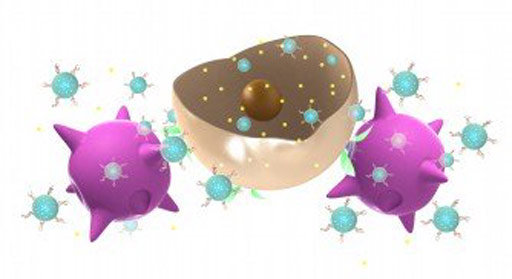Researchers Demonstrate Potential of Drug Delivery System for Melanoma
By LabMedica International staff writers
Posted on 12 Jan 2017
A novel delivery system for anticancer drugs is based on biodegradable theranostic nanoparticles transported by immune cells that are naturally attracted to the site of the growing tumor.Posted on 12 Jan 2017
Theranostic (combination of diagnostic and therapeutic) nanomedicine is emerging as a promising therapeutic approach. It takes advantage of the high capacity of nanoplatforms to ferry cargo and loads onto them both imaging and therapeutic functions. The resulting nanosystems, capable of diagnosis, drug delivery, and monitoring of therapeutic response, are expected to play a significant role in the era of personalized medicine, and much research effort has been devoted toward that goal. A convenience in constructing such function-integrated agents is that many nanoplatforms are already, themselves, imaging agents. Their well-developed surface chemistry makes it easy to load them with pharmaceutical agents and promote them to be theranostic nanosystems.

Image: An artist’s conception of nanoparticle-carrying immune cells that target tumors and release drug-loaded nanoparticles for cancer treatment (Photo courtesy of Jian Yang and Yixue Su, Pennsylvania State University).
Investigators at Pennsylvania State University developed a novel drug delivery system for treatment of melanoma that used immune system macrophages as both nanoparticle (NP) carriers and navigators to achieve cancer-specific drug delivery.
Theranostic NPs were fabricated from a unique polymer, biodegradable photoluminescent poly (lactic acid) (BPLP-PLA), which possessed strong fluorescence, biodegradability, and cytocompatibility. In order to minimize the toxicity of cancer drugs to immune cells and other healthy cells, an anti-BRAF V600E mutant melanoma specific drug (PLX4032) was loaded into the BPLP-PLA nanoparticles. Muramyl tripeptide was also conjugated onto the nanoparticles to improve the nanoparticle loading efficiency.
The investigators reported in the December 27, 2016, online issue of the journal Small that the nanoparticles were internalized within macrophages, which were tracked via the intrinsic fluorescence of BPLP-PLA. Macrophages carrying nanoparticles delivered drugs to melanoma cells selectively via cell to cell binding. Pharmacological studies indicated that the PLX4032 loaded nanoparticles effectively killed melanoma cells in cultures under conditions that mimicked those that would be found in the body.
“The traditional way to deliver drugs to tumors is to put the drug inside some type of nanoparticle and inject those particles into the bloodstream,” said senior author Dr. Jian Yang, professor of biomedical engineering at Pennsylvania State University. “Because the particles are so small, if they happen to reach the tumor site they have a chance of penetrating through the blood vessel wall because the vasculature of tumors is usually leaky.”
“I have 10 years of working in immunology and cancer,” said contributing author Dr. Cheng Dong, professor of biomedical engineering at Pennsylvania State University. “Jian is more a biomaterials scientist. He knows how to make the nanoparticles biodegradable. He knows how to modify the particles with surface chemistry, to decorate them with peptides or antibodies. His material is naturally fluorescent, so you can track the particles at the same time they are delivering the drug, a process called theranostics that combines therapy and diagnostics. On the other hand, I study the cancer microenvironment, and I have discovered that the microenvironment of the tumor generates kinds of inflammatory signals similar to what would happen if you had an infection.”







 assay.jpg)





